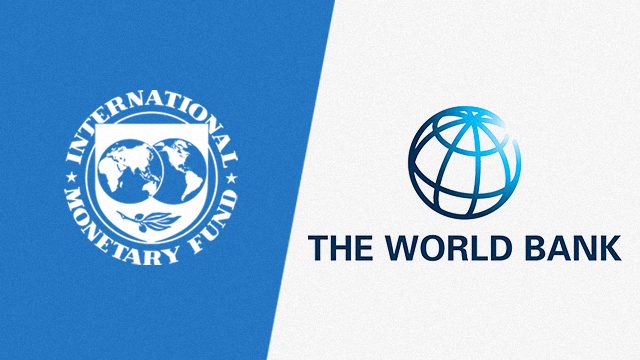SUMMARY
This is AI generated summarization, which may have errors. For context, always refer to the full article.

WASHINGTON, USA – The International Monetary Fund (IMF) and World Bank have aggressively pushed out financing to help countries deal with the health and economic impacts of the coronavirus pandemic.
Here is a summary of the financing available from the Washington-based development lenders:
Regular lending capacity
All members of the IMF have access to the $1 trillion in lending capacity.
As of Thursday, April 16, 102 out of 189 IMF member countries had made requests for aid, and 50 of them will receive it by the end of April, IMF chief Kristalina Georgieva said following the virtual spring meetings.
The World Bank plans to provide up to $160 billion in aid over the next 15 months.
Emergency aid
The IMF’s emergency aid capacity recently was doubled to $100 billion, available through two tools: the Rapid Financing Instrument (RFI) and the Rapid Credit Facility (RCF).
The RCF is interest-free and accessible to low-income members, while the RFI is accessible to all members, without the need to negotiate a traditional loan program.
The funds “can be disbursed very quickly to assist member countries implement policies to address emergencies such as the coronavirus,” the IMF said.
Disaster relief
The IMF also uses its redesigned Catastrophe Containment and Relief Trust (CCRT) to provide grants for debt relief to the poorest and most vulnerable countries with outstanding obligations to the IMF to help address disasters, including public health disasters.
This instrument was used to support Guinea, Liberia, and Sierra Leone during the 2014 Ebola epidemic.
The IMF board approved a 6-month debt payment standstill for 25 countries eligible for CCRT funding, which potentially could be extended.
Georgieva put out an urgent call for donations to boost resources of this fund, and she said on Thursday the IMF has received commitments totaling $600 million from Britain, Japan, China, the Netherlands, and Germany.
Poverty reduction fund
Georgieva also has called for an additional $17 billion in donations to shore up the Poverty Reduction and Growth Trust (PRGT), which provides concessional lending to low-income countries.
She said the fund already has received commitments for 70% of this amount from Japan, Britain, France, Australia, and Canada.
United States Treasury Secretary Steven Mnuchin said the US is considering a possible contribution.
Short-term credit line
For countries that are not eligible for concessional lending, the IMF on Wednesday, April 15, approved a new Precautionary Liquidity Line (PLL) to help countries with “sound policies” deal with “adverse shocks” from the coronavirus.
The countries that qualify can draw on the credit backstop for 6 months, 1 year, or 2 years.
Funding field projects
The World Bank intends to roll out $160 billion over the next 15 months in countries like Ethiopia, Afghanistan, Haiti, Ecuador, India, Mongolia, and Tajikistan to strengthen their medical resources to respond to the pandemic’s immediate health crisis and bolster economic recovery.
The bank already has pushed out fast-track financing, with programs underway in 25 countries totaling $1.9 billion, and others moving forward in 40 countries amounting to $1.7 billion. (READ: World Bank loans $500 million to PH for coronavirus response)
The focus is on “fast, broad-based action, especially for the poorest countries,” World Bank President David Malpass said on Thursday.
“By the end of April, we expect to have COVID-19-related projects in 100 countries, and we are taking steps to provide unprecedented financing to help countries respond to the crisis.” – Rappler.com
Add a comment
How does this make you feel?
There are no comments yet. Add your comment to start the conversation.